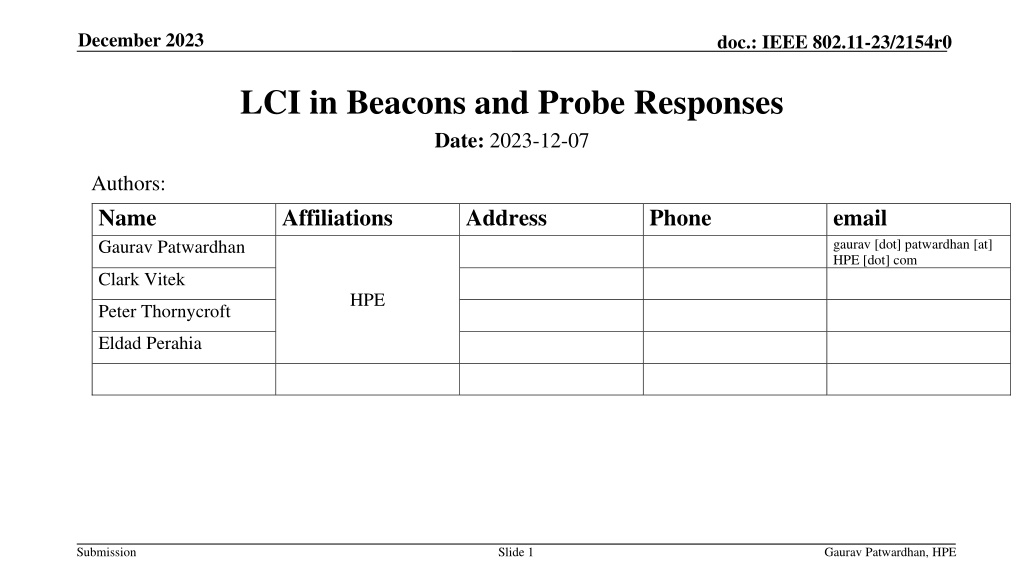Proposal for Location Configuration Information (LCI) in IEEE 802.11 Beacons and Probe Responses
This document proposes the inclusion of Location Configuration Information (LCI) data in a standard information element broadcast in Beacons and Probe Responses within IEEE 802.11 networks. By enhancing the accessibility of infrastructure location to non-AP STAs, this proposal aims to simplify location determination processes indoors where WLAN is predominant. The proposal addresses limitations of current methods and suggests a standardized approach for APs to provide LCI in network frames.
Download Presentation

Please find below an Image/Link to download the presentation.
The content on the website is provided AS IS for your information and personal use only. It may not be sold, licensed, or shared on other websites without obtaining consent from the author. Download presentation by click this link. If you encounter any issues during the download, it is possible that the publisher has removed the file from their server.
E N D
Presentation Transcript
December 2023 doc.: IEEE 802.11-23/2154r0 LCI in Beacons and Probe Responses Date: 2023-12-07 Authors: Name Gaurav Patwardhan Affiliations Address Phone email gaurav [dot] patwardhan [at] HPE [dot] com Clark Vitek HPE Peter Thornycroft Eldad Perahia Submission Slide 1 Gaurav Patwardhan, HPE
December 2023 doc.: IEEE 802.11-23/2154r0 Abstract This document presents a proposal to include Location Configuration Information (LCI) data in a standard information element (IE) that can be broadcast in Beacons and included in Probe Responses. Background and purpose of the proposal is provided. Submission Slide 2 Gaurav Patwardhan, HPE
December 2023 doc.: IEEE 802.11-23/2154r0 Why LCI in Beacons and Probe Responses? Non-AP STAs and their applications would like to determine their location from the WLAN infrastructure, particularly indoors where WLAN is the dominant and preferred network. When desired to be shared by the infrastructure provider, including the LCI in Beacons and Probe Responses will make the infrastructure location available to the greatest number of 802.11 capable non-AP STAs. Current available methods (next slide) are limited in devices that support them and/or cumbersome with additional conditions required for non-AP STAs to obtain LCI from the infrastructure it can all be made MUCH simpler and much more accessible. Submission Slide 3 Gaurav Patwardhan, HPE
December 2023 doc.: IEEE 802.11-23/2154r0 Background on Existing LCI Methods Type of Exchange/ Reference (REVme D4.1) Advantages Limitations Procedure FTM Exchange (4.3.21.19, table 9-136 measurement type 8) Provides Ranging and LCI information Newest generation hardware only (802.11-2020). [Also applicable to 802.11az capable hardware]. Does not scale beyond a few non-AP STAs. Active exchange GAS/ANQP (9.4.5.12 Geo element, 9.4.5.13 Civic element) Many elements available in addition to LCI via ANQP Limited query interval. Does not scale beyond a few non-AP STAs. Low complexity devices cannot get LCI information. Neighbor Report (9.4.2.35, subelement 39 measurement report of type LCI) Can include multiple neighboring BSSs Associated non-AP STAs only. Does not scale beyond a few non-AP STAs. Request Element (9.4.2.8/9.4.2.9) Can be used to directly request LCI in a response frame Initiated by non-AP STA only, not infrastructure. Does not scale beyond a few non-AP STAs. DSE (9.4.2.50) Includes LCI in Beacon along with dependent station enablement (DSE) Previously limited purpose (DSE) 3.6 GHz Frequency Band, (licensed) Altitude in meters only, no civic support Broadcast in beacons Submission Slide 4 Gaurav Patwardhan, HPE
December 2023 doc.: IEEE 802.11-23/2154r0 Proposal APs Provide a standardized method for APs to include LCI in Beacons and Probe Responses. Simply create a new information element, using already defined LCI Field Format [9.4.2.20.10 LCI Report.] Non-AP STAs Non-AP STAs can optionally decode the LCI or forward Beacon and Probe Response frames elsewhere for processing. Submission Slide 5 Gaurav Patwardhan, HPE



























